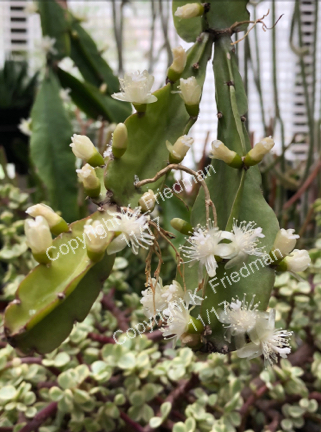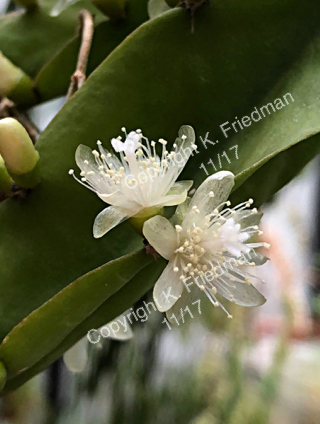Rhipsalis agudoensis Tayl 2003/CSI 16: 12. ( syn. Rhipsalis pachyptera) |
|
Treated as species in its own right by Korotkova 2011. Treated as a synonym
of Rhipsalis pachyptera in Calvente Thesis 2010 Rhipsalidi cereoidi primo adspectu habitu similis, sed segmenta caulium alata incisa; R russellii etiam similis sed flores majores segmentis perianthii multis instructi. Holotypus Brazil, Rio Grande do Sul. Mun. Agudo, before 1989, Horst-Uebelmann 821, cult hort. Uhlig-Kakteen, Kernen, Germany. June 2003 (K, alc.). During the June visits to the living collections at the University of Bonn, at the home of Andreas Hofacker (Boblingen) and at Uhlig-Kakteen (Kernen, near Stuttgart), reported on elsewhere in this issue of CSI, the author was able to re-acquaint himself with a curious Brazilian Rhipsalis previously mentioned under R. pachyptera in Barthlott & Taylor's ‘Notes’ {Bradleya 13: 61. 1995}: This plant, which is superficially similar in its vegetative morphology to both R. russellii and R. cereoides, is known from a single site and collection made at Agudo, in the centre of the state of Rio Grande do Sul (Horst-Uebelmann 821). Prior to June this year I had not been able to aee the plant in flower or fruit, but at the Hofacker and Uhlig collections it was fully fertile. From study of material generously donated by Andreas Hofacker and Matthias Uhlig it is now possible to confirm that, while it is seemingly related to R. pachyptera Pfeiffer, it does represent a new species and a very distinct one at that. The plant produces stiff robust stems of spreading to pendulous habit; stem segments of determinate growth, to c. 15 x 4 cm, slightly tapered to the base, 3-4(-5)-angled/winged, but notched at the areoles and mostly spineless; flowers are borne 1 to few together, c, 1.5-2.0 cm Ø, with c. 11 narrow, white perianth-segments visible from above; and fruit up to 6 x 5 mm, pale to magenta-pink depending on age and exposure to sun. The following diagnosis and holotype are needed to establish this taxon: According to Andreas Hofacker (pers. comm.) the plant is known only from a single hill at Agudo and was not seen by Horst & Uebelmann elsewhere. From this it may be suspected that the species is likely to have a Red List status of Critically Endangered (Criteria B1a+b(iii), B2a+b(iii)). Notes from Alice Calvente 10/2004
|

